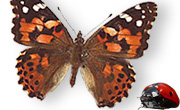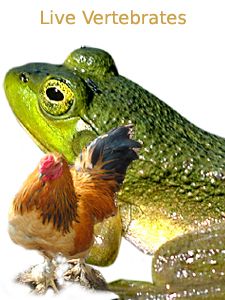Fax: (916) 381-4006



Live Vertebrates |
 The Vertebrata, or vertebrates, is a very diverse group, ranging from lampreys to Man. It includes all craniates, except hagfishes, and are characterized chiefly by a vertebral column, hence their name. The Vertebrata, or vertebrates, is a very diverse group, ranging from lampreys to Man. It includes all craniates, except hagfishes, and are characterized chiefly by a vertebral column, hence their name.
The majority of the extant vertebrates are the jawed vertebrates, or gnathostomes, but lampreys are jawless vertebrates. However, in Late Silurian or Early Devonian times, about 420 to 400 million years ago, the situation was reverse, and the majority of the vertebrate species were jawless fishes (the "ostracoderms", presumably more closely related to the gnathostomes than to lampreys). The decline of the jawless vertebrates and the subsequent rise of the gnathostomes took place about 380 million years ago. Although not the most numerous group of animals in either number of individuals or in number of taxa, the vertebrates are an endlessly fascinating group of animals. Vertebrates are interesting partly because we are intimately familiar with them, but also because we ARE them. Our species, Homo sapiens, is included within the Vertebrata.
|
| Featured Items |
|---|
| Bullfrogs 5-6" Live - 12+... |
 The American Bull Frog (Lithobates) is an aquatic frog, a member of the family Ranidae, or "true frogs&qu...
The American Bull Frog (Lithobates) is an aquatic frog, a member of the family Ranidae, or "true frogs&qu... |
|
Read more »»»
$28.00 (Buy Now) |
|---|
| Gambusia - Each |
 The mosquitofish, Gambusia affinis (Baird & Girard, 1853), is a species of freshwater fis...
The mosquitofish, Gambusia affinis (Baird & Girard, 1853), is a species of freshwater fis... |
|
Read more »»»
$0.95 (Buy Now) |
|---|
| Grassfrogs Live - 2.5 - 3... |
 Leopard frogs, which are also called meadow frogs and grass frogs, are a col...
Leopard frogs, which are also called meadow frogs and grass frogs, are a col... |
|
Read more »»»
$5.80 (Buy Now) |
|---|
| Slider Turtles 8-10-in. L... |
 Trachemys is a genus of water turtles found in North, Central, and South America. They are commonly known as &...
Trachemys is a genus of water turtles found in North, Central, and South America. They are commonly known as &... |
|
Read more »»»
$17.88 (Buy Now) |
|---|
9298 Elder Creek Road
Sacramento, CA 95829
(916) 386-2665
9298 Elder Creek Road
Sacramento, CA 95829
(916) 386-2665